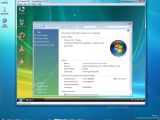Just under a month ago, Microsoft made public its SKU (Stock Keeping Unit) strategy for Windows 7, while simultaneously delivering a sneak peek into the upgrade option details associated with the operating system. Although in a delicate and continually evolving market share ballet, both Windows XP with 63.76% and Windows Vista with 22.48% (according to Net Applications) are equivalent to nothing short of a fair game for Windows 7.
Because, make no mistake about it, Windows 7 will grow its installed base for the most part to the detriment of its precursors. In this context, the Redmond company has built a veritable bridge between Windows 6.0 (Vista) and Windows 6.1 (Win 7), when it comes down to in-place upgrades. However, the same is not valid for Windows XP and Windows 7. In fact, the software giant is making sure that the gap between the two operating systems is widened by the absence of in-place upgrade options.
Still, the good news is that Microsoft will make available Windows 7 upgrade licenses for both Vista and XP. The price is, of course, a critical factor when considering a jump to the next iteration of Windows, for both those that have coughed up a pretty dollar to upgrade to Vista, and also for the customers that have ridden XP for all its got, skipping the intermediary Windows 6.0 step. The bad news, as far as Windows XP users are concerned, is that Microsoft will not support in-place upgrades from XP to Windows 7. They will need to perform a clean installation of Win 7 on top of XP. Only Vista machines will be able to be upgraded in-place to Windows 7.
In-place upgrades are one of the installation options for Windows operating systems. Microsoft reveals that the process allows users to “install Windows and retain applications, files, and settings as they were in previous edition of Windows.” And fact is that, in the context in which users have gathered a consistent volume of programs along with extensive customization, in-place upgrades make all the sense in the world, especially in scenarios in which re-installing all applications after a clean deployment of Windows would take in excess of a couple of hours. This because the upgrading process is completely automatic, following the initial steps that the end-user has to perform manually.
Essentially, upgrading to Windows 7 is a way to ensure that the operating system does all the heavy lifting, and, even if it is indeed a time-consuming process, stretching at least three or even four times as much as a clean install, the actual effort on behalf of the end-user is minimal.
Vista SP1 to Windows 7 in-place upgrade
The evolution from Vista to Windows 7 has also marked the evolution of the upgrading process. You will have to stare at the Upgrading Windows window for no less than an hour and a half and live through four reboots. At least I had to, as I upgraded a Vista SP1 Ultimate copy to Windows 7 Beta Build 7000 Ultimate edition, both operating systems used as guests in a Virtual PC 2007 SP1 virtual machine running with 2GB of RAM.
For once, Microsoft provides the user with much more information when it comes down to the progress of the upgrading process. They will be able to see the volume of installation files that have already been copied along with the corresponding percentage out of the total number of items at any time. Microsoft is, however, not delivering an estimate of the time remaining, and only saying that the process is bound to take several hours. And the software giant is, by no means, kidding. For the upgrade, the operating system will copy the Windows 7 installation files, then gather files, settings and programs, then expand the files, install features and updates, and only then completes the upgrade (the part that will deal with migrating settings files and programs).
For Virtual PC 2007 VMs, the upgrading process literally flies when the capture ISO option is used and files are accessed from a Windows 7 Beta Build 7000 ISO on the hard disk. Using the actual DVD drive doesn’t even compare in terms of speed, but the experience, painfully slow, is closer to what end-users will run into in a real life upgrade scenario. For this test, I used a combination of both upgrading via the physical DVD drive, and capturing an ISO, in order to get the feeling of what the actual process might be like, respectively to expedite non-essential aspects. I also increased the amount of RAM assigned to the VM to 2.5GB. Throughout the upgrade, both Vista and Windows 7 offer the user the possibility to Roll Back to the previous version of Windows, during reboots.
XP SP3 to Windows 7 in-place upgrade
“There has been a lot of noise about the fact that Microsoft is not providing an in-place upgrade for Windows XP users to Windows 7. This is ironic considering that during the Vista launch, I got laughed at every presentation for actually recommending an in-place upgrade to Vista. No one believed me on how easy and flexible a Vista upgrade was. People, instead, wanted to believe the tried and true mantra of rebuild and reinstall. For business and enterprise, this method makes the most sense since user data typically sits off the actual computer. With Windows 7, the likely reason that Redmond didn’t support an XP upgrade is due to the amount of validation and testing required to support it to Microsoft’s standards. With such an aggressive schedule, my opinion is that those testing hours can be better utilized for other things like compatibility and performance. Nevertheless, IT admins aren’t completely out of options,” Viral Tarpara, Microsoft IT pro evangelist, reveals.
Believe it or not, the Windows Vista Service Pack 1 to Windows 7 Beta upgrade featured in the first part of this article is actually a continuation of an initial XP SP3 to Vista SP1 upgrade. As you can see, the name of the virtual machine running under Windows 7 remains the same throughout the two upgrading processes, namely SoftpediaXPSP3, which has been the guest OS running in the original VM. Yes, it can be done, via Windows Vista, but it can be done nonetheless, with the proverbial “Where there’s a will, there’s a way” at work. Direct Windows XP to Windows 7 upgrades are, indeed, not possible, Microsoft wasn’t bluffing when it said that such scenarios would not be supported. But there is a viable alternative. However, it involves a Windows Vista detour. That’s right… XP can be upgraded in-place to Vista, which in its turn can be upgraded in-place to Windows 7. Trust me, it sounds more complicated than it actually is.
If Windows Vista to Windows 7 in-place upgrades offer users information on the installation files being copied, as well as on the progress of expanding those files, and even on the files, settings and programs being migrated as a part of completing the upgrade stage, XP to Vista upgrades leave customers in the dark. The process will go through no less than four reboots, and, for a 2GB of system memory virtual machine, lasts over an hour and a half. As part of wrapping up the Windows 7 upgrade, the operating system will also contact Microsoft and send “diagnostic information” to the Redmond company. The end-user has no say in and no control over the diagnostics information that Windows 7 sends to Microsoft. UPDATE: By installing the beta version, you're automatically opting into the Customer Experience Improvement Program. (thank you Eric)
The actual XP SP3 to Vista SP1 upgrade went as smooth as possible. As you can see from the screenshots integrated with this article, the operating system only flagged a few potential incompatibility issues, but nothing severe enough that the move could not be made. I would like to tell you that the results were just as “perfect,” but I can’t. Windows Vista failed to play nice with the audio driver, and my network connection to the Internet was dead, despite the correct driver being installed. Still, I must point out that the XP to Vista upgrade process cannot be blamed for this, as it is performed in a virtual environment. I suspect the same range of issues would not have affected the upgrade process, had it been performed on physical machines.
The truth
I’ll be honest. The results are better than expected. Much better. But is it worth it? Is it worth spending in excess of three hours upgrading from XP to Vista and then repeating the process again with Windows 7? Well, it can be done, and some will undoubtedly turn to this alternative. As you can see, the initial three applications I had installed on Windows PX SP3, namely Firefox, VLC and Winamp, have survived all the way to Windows 7, and are functional, even my browsing history has been transitioned from XP to Vista and to Windows 7. The same will undoubtedly be the case with all applications installed, as long as there are no incompatibility conflicts. Users that have a pile of programs installed and simply do not want the extensive labor of getting every application deployed and set up again should definitely resort to the double upgrade trick.
“Vista had many ways to be deployed and in-place XP upgrades were one of them. Because of the small number of core differences between Vista and Windows 7, it makes sense for IT pros that need to do an in-place upgrade, simply move to Vista first. Sure this adds additional work, but if you are deploying correctly and according to best practices using our free deployment tools, then at most you are adding an addition 30-45 minutes to your migration process for the end-user,” Tarpara states.
Tarpara’s advice is obviously for IT professionals, but it’s also valid for the rest of the end-users. With the mention that preparation is the key. The ugly side of the double upgrade process is that any issues that have survived from XP to Vista will also move to Windows 7. I must emphasize that Windows 7 will in no way act as a panacea for the problems that have impacted the XP to Vista upgrade. As you can see, my Windows 7 Beta Build 7000 doesn’t feature the audio drivers, and still doesn’t have a network connection. Users that are looking to upgrade from XP to Vista and to Windows 7 will need to take all the steps necessary to ensure that the XP to Vista move will not result in any problems.
For IT professionals Tarpara points out the deployment procedure for IT pros. “– Audit XP environment with: Windows Vista Hardware Assessment. Assess PCs network-wide with Windows Vista Hardware Assessment to determine the PCs’ readiness for Windows Vista upgrades, including hardware and device driver compatibility. Application Compatibility Toolkit - inventory and analyze your organization's applications to ensure they work with Windows Vista. Comprehensive Agentless Planning and Auditing can be done by Microsoft Assessment & Planning Toolkit (MAP) – This is the best route:
– prep Vista SP1 image and configure unattended install with WAIK – put script, image, and config information on a network share – send email out to selected people that their machines have been chosen for an upgrade and ask to click on a network share install link. – machine magically upgrades from XP to Vista with user state intact – Now follow standard Windows 7 upgrade procedure outlined in MDT 2010 documentation.”
What would I do, having already gone through the process of upgrading from XP SP3 to Vista SP1 just to do it all over again to Windows 7? I would just perform a clean install of Windows 7 and get it over with. Mind you, my test was performed with little actual preparation to ensure that everything would go as smooth as possible, and, as a result, I ended up with a copy of Windows 7 Beta with no audio drivers and no Internet connectivity. Of course, preparation would have undoubtedly bypassed all these problems, but I think that the effort involved would be equivalent to that of a clean install. Still, if there are critical applications installed, complex configuration and unique settings, all of which need to survive intact, XP to Vista to Windows 7 in-place upgrades are the key.

 14 DAY TRIAL //
14 DAY TRIAL // 





































































